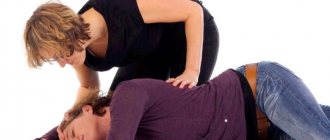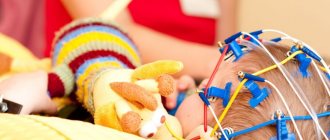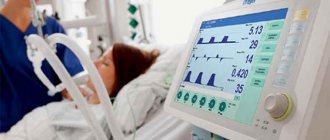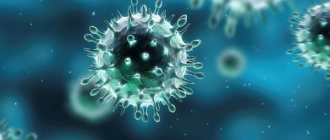Cramps in the leg muscles sometimes worry most of the adult population, disrupting the usual rhythm of life for a long time.
Cramps are manifested by unconscious contractions or excessive tension of one or more muscles, accompanied by severe pain. This allows us to divide them into types:
- Clonic - a similar version of convulsive muscle contractions is an instantaneous compression and relaxation of muscles, similar to a nervous tic of the facial muscles;
- Tonic - this type of cramp manifests itself in the form of a prolonged contraction of the muscle, accompanied by severe pain. The pain may disappear after the spasm is relieved, or the problem muscle may be bothered by symptoms of discomfort for several days;
Often painful cramps in the leg muscles are of the tonic type. Spastic contractions of the leg muscles almost always occur at night. It is very difficult to predict the moment of their occurrence. Before cramps occur, many people feel fatigue, tension and soreness in the muscles of the lower extremities.
The spasm appears unexpectedly and lasts 5-6 minutes, which can be taken as a significant period of time. They can appear in the muscles of the lower extremities, abdominal muscles, and muscles of the upper extremities. In fact, the pain they cause is difficult to bear, and a patient who experiences seizures needs urgent help.
The appearance of severe muscle spasms can occur at any period of a person’s life, but patients in the middle and older age groups are primarily prone to them. With rare repetitions of spasm, there is no reason to worry. Repeated, severe, painful manifestations may be signs of a developing serious illness. With such symptoms, you definitely need to see a therapist. After the examination and necessary tests, the doctor will refer you for a consultation to the right specialist.
What is a cramp
A cramp or spasm is an involuntary and uncontrollable muscle contraction that is accompanied by aching pain. During a spasm, it is impossible to control the limbs, which is why the only way out is to wait out the attack.
Such muscle contraction is the body’s reaction to an irritant. These include low temperature (cramp in cold water), illness, stress, and much more. Below are the main prerequisites for the occurrence of spasm:
- brain diseases;
- diseases of the cardiovascular system;
- damage to one or more nerves;
- excessive physical activity;
- chronic kidney disease;
- severe dehydration;
- last trimester of pregnancy;
- excess phosphates;
- oxygen toxicity (breathing too quickly);
- lack of vitamins;
- thyroid diseases;
- effect of medications.
Often the cause is an excess of central nervous system stimulants in the blood (caffeine and nicotine), as well as hypothermia. If you were involved in sports before the attack, then most likely the “culprit” is a pinched nerve that provokes a spasm. Serious health problems are characterized by an abundance of symptoms, and seizures only complement the overall picture.
In some cases, seizures occur due to poisoning of the body. People who regularly drink alcohol or drugs experience spontaneous muscle contraction. This can also be caused by viral diseases. During their life, microorganisms release large amounts of toxins into the blood, which leads to intoxication.
Quite rarely, limbs cramp due to a lack or excess of minerals (calcium and magnesium). This is associated with a poor diet or dysfunction of the gastrointestinal tract.
Forms of attacks
Conventionally, the forms of myoclonus have acquired the names benign and negative. Benign myoclonus does not require treatment. As a rule, they are observed at night or when a person falls asleep. The duration of the attacks is short - up to several minutes.
In a conscious state, fear myoclonus occurs. Spasmodic conditions are provoked by a sharp cry, the fall of any object, or bright flashes of light. The condition is accompanied by tachycardia and sweating. As a result of an attack, hiccups sometimes occur. Involuntary hiccups also indicate chronic diseases of the gastrointestinal tract and intoxication of the body.
Paroxysmal numbness of the calf muscles and eye tics indicate physical overexertion. Such benign myoclonus is typical for children in the first months of life, observed during sleep, and during lactation. Myoclonus cannot be ruled out when the child falls asleep.
Negative myoclonus refers to epileptic seizures. A clear example of the mentioned attacks in children and adults is a slight tremor of the arms when in an extended position. An attack occurs in any type of muscle tissue, even the tongue.
Symptoms
It is difficult to confuse a spasm with the manifestation of another disease. At the same time, convulsive muscle contractions vary in different cases, which helps to make a diagnosis.
Main features:
- strong muscle tension, manifestation of relief;
- lack of control over limbs;
- the hand is clenched into a fist or straightened as much as possible;
- sharp sharp or nagging pain;
- skin changes color (in case of poisoning);
- spasm gives way to relaxation, twitching occurs (with problems with the central nervous system).
Additional symptoms accompanying seizures are an indicator of a serious illness. If during an attack your vision darkens, your blood pressure rises, nausea and dizziness appear, then you have problems with the nervous system. With rare exceptions, this is associated with severe stress.
What to do if you have hand cramps
If spontaneous muscle contraction does not cause serious discomfort, then it is enough to wait out the attack. There is no need to panic or call the hospital unless you are sure that you do not have serious health problems. In this case, you should evaluate your condition, and in case of dizziness or nausea, seek help.
USEFUL INFORMATION: Why people snore in their sleep: reasons and how to deal with it
If the symptom occurs at night while sleeping
If you wake up at night with a spasm in your hands, then the following tips will help alleviate the condition at the time of the attack:
- lying in bed, raise your arms and bend and straighten your fingers several times;
- rotate your wrists alternately to the right and left;
- clasping your fingers together, raise and lower your hands. Change the grip of your fingers and perform the exercise again;
- Having relaxed your hands, shake your hands several times for maximum relaxation;
- rub your palms until you feel warm and massage each finger;
- perform exercises with a massage ball for the hands: squeeze the ball, holding it with one hand and then the other, roll it between your palms. Such manipulations create a targeted effect on spasmodic muscles, which leads to their relaxation.
If the symptom occurs during the day while awake
First aid for a spasm will help you avoid getting into a dangerous situation on the road or at work. It is important to remember that this is only a temporary measure and not a complete solution to the problem.
- When working monotonously with hands or forearms. If you constantly perform the same action, then spasm is a standard symptom of limb fatigue. To prevent an attack, you need to do short-term exercises every half hour. It is enough to stretch your hands, shoulders and forearm to improve blood circulation.
- With static load on the hands. This is typical for truckers who are forced to hold their limbs in one position for hours. At the moment of spasm, in order to avoid an accident, you should quickly prick the area of the arm. You can use a needle, any iron tool or clothespin. The main thing is that you do not break the skin and do not receive severe injury. It is also necessary to lower your arms down to normalize blood flow. With hand cramps, rhythmic flexion and extension of the little fingers helps.
- When your arms are raised up for a long time. Builders and installers suffer from arm spasms because their limbs are higher than their hearts. The muscles are poorly supplied with blood, which is why they lack oxygen. In this case, it is enough to lower your hands down and stretch them rhythmically.
How to treat leg cramps at night?
Leg cramps never occur on their own. To prevent their development, it is necessary to influence the cause that led to the occurrence of a convulsive attack.
Activities may be as follows:
- To prevent dehydration, you need to drink enough water. This is very important for proper muscle function. This rule is especially relevant for the hot season, as well as for people involved in active sports. It is best to give preference to mineral water, rich in beneficial microelements.
- If you lose fluid during vomiting or diarrhea, you need to drink enough water. Experts advise taking rehydration solutions (Regidron, Gidrovit, etc.). If after a few hours the situation does not improve, then you should seek medical help.
- To prevent seizures from taking medications, you must strictly follow your doctor’s recommendations. If, despite this, muscle spasms continue to haunt a person, then the question of reviewing therapy needs to be raised.
- To avoid leg cramps during pregnancy, a woman needs to take vitamin and mineral complexes.
- Patients with liver cirrhosis should receive adequate treatment for the disease, take hepatoprotectors, follow a diet, and stop drinking alcohol. When fluid accumulates in the abdominal cavity, it needs to be pumped out.
- If the cause of leg cramps lies in varicose veins, then you need to follow a diet aimed at reducing excess weight. You should definitely stop smoking. When varicose veins have just begun to develop, wearing compression garments can help. Cramps may stop bothering you when a person begins to receive treatment with venotonics in creams and ointments (Troxevasin, Venitan, etc.), as well as in tablets (Eskuzan, Detralex, Phlebodia 600, etc.). If conservative treatment does not help cope with the existing problem, then surgery is necessary.
- Patients with diabetes should make every effort to keep their glucose levels under control. This will stop the progression of the disease and prevent serious complications from developing. At the initial stage of diabetes, you can try to adjust your menu, adhere to a strict diet and increase physical activity. If this does not help, then treatment is supplemented with sugar-burning drugs and/or insulin injections.
- To relieve spasm from blood vessels, which causes leg cramps during obliterating endarteritis, it is necessary to take antispasmodics, for example, Drotaverine. Antibiotics and corticosteroids are prescribed to reduce inflammation in the veins. The patient should receive vitamins and anticoagulants. If a patient develops ulcers on his legs, then surgical intervention is necessary to reconstruct the veins or improve the functioning of the blood vessels.
- If leg cramps develop due to flat feet, then treatment should be started as early as possible. Conservative therapy is effective only at the first stage of the disease. If a person is overweight, he needs to lose weight, follow a diet, and reduce the load on the foot. At the next stages of development of the pathology, surgery is indicated for the patient.
- Vitamin D must be given to the child in strict accordance with the dosage prescribed by the doctor.
- To prevent the development of leg cramps at night with Raynaud's syndrome, the limbs must be kept warm. It is possible to take drugs such as Nifedipine, Verapamil, Captopril, Ketanserin. In parallel, therapy is carried out for the underlying disease, which provoked the development of Raynaud's syndrome. Physiotherapeutic procedures, reflexology, hyperbaric oxygenation, etc. have proven themselves well.
- To prevent seizures with hyperparathyroidism, a person should be regularly examined by an endocrinologist. His menu should include foods such as vegetables, fruits, and dairy drinks. They are rich in calcium and magnesium, but deprived of phosphorus, which is important for such patients. In parallel, calcium supplements with ammonium chloride and vitamin D supplements are prescribed.
- If a child is prone to febrile convulsions, then it is necessary to give him antipyretic drugs in a timely manner, preventing the body temperature from rising to high levels.
- It is imperative to take magnesium with vitamin B6 if seizures are caused by a deficiency of this microelement. As a rule, the full course of treatment should be about 8 weeks. After this time, cramps will stop bothering the person. Drugs for treatment: Magnistad, Magnelis B6, etc. At the same time, you need to eat foods rich in magnesium: parsley, onions, dill, dried apricots, prunes, bran, beans, legumes, seaweed.
- If seizures develop due to a deficiency of B vitamins, then a course of injections with the drug Milgamma should be performed. You need to start with 5 injections, give them every other day. If you feel better, then you need to give 5 more injections.
- If there is a deficiency of calcium in the body, it is necessary to take it in tablets. You can choose a combined form of medication, where calcium is combined with vitamin D. This way it is better absorbed. The course of treatment is 30 days. At the same time, you need to enrich your menu with foods with calcium: cottage cheese, cheese, sesame seeds, fermented milk drinks, broccoli.
- To relax muscles, muscle relaxants can be used, such as: Mydocalm, Tolperisone, Sirdalud, Baclofen.
Maintaining a healthy lifestyle, quitting smoking and drinking alcohol is an excellent prevention of leg cramps.
Video: neuropathologist on the causes and treatment of seizures during sleep:
Treatment Options
If spasms and twitching of your hands have become a daily problem for you, then you should seek help from specialists. There are several treatment options that can solve the problem.
Medication
Cramps are a specific symptom. Therefore, various drugs are used that help relieve pain, relax muscles, or eliminate mineral deficiencies.
| Name of medicine | Purpose |
| "Magnefar V6" "Magvit" "Magnemaks" "Magnikum" "Magne V6" | Eliminating magnesium deficiency |
| “Calcium D3” “Calceos” “Binocal” “Beresh calcium plus D3” | Elimination of calcium deficiency |
| "Asparkam" "Panangin" | Eliminating potassium deficiency after using diuretics |
| Valerian tincture alcohol. "Alluna" "Valdispert" Valerian extract | Depressant |
| "Curantil" "Dipyridamole" "Nikoshpan" | Normalization of blood circulation |
| "Spazmalgon" "Baralgetas" "Baralgin" "Renalgan" "Reonalgon" | Relieving smooth muscle spasm |
USEFUL INFORMATION: Why people talk in their sleep: reasons
The drugs help partially solve the problem with seizures. It should be remembered that using them at high temperatures, viral diseases (intoxication), and also for epilepsy is prohibited.
All drugs with targeted action must be prescribed by a doctor. Before the examination, you should not purchase medications that reduce/increase blood pressure or affect the heart or central nervous system. Be aware that some pills can also cause cramps (a side effect). Without an accurate diagnosis, taking medications is dangerous.
Folk remedies
If you do not want to purchase expensive medicines or for health reasons you cannot take them, then turn to traditional medicine.
- Mustard plasters. A cheap way to warm up and relax the muscles of the limbs. They improve blood flow, providing muscles with oxygen. The duration of the procedure is 15 minutes.
- Pepper patch. It warms up much better than mustard plasters, therefore it is more effective. However, the chance of skin burns increases.
- Linden infusion. Fill a half-liter jar with freshly picked flowers, pour boiling water over it and close tightly. After 20 days, the infusion can be consumed. Reception regimen - 1 tbsp. l. three times a day before meals.
- Phytotherapy. Teas based on linden or chamomile help get rid of cramps. When taken before bed, they quickly calm the central nervous system and improve the quality of sleep.
- Lemon based compress. Fresh, high-quality fruit is cut into several slices and the juice is rubbed on the skin of the hands. Next, wrap it with gauze or other material that allows air to pass through. The procedure is carried out before bedtime.
How to deal with cramps during sleep?
- Be sure to find out the reason for their occurrence.
- Review your diet by including foods containing magnesium and calcium, vitamins B6 and D for their absorption.
- Carry out vitamin therapy.
- Avoid muscle strain.
- Perform simple muscle stretching exercises.
- Before going to bed, do contrast baths for your feet.
- Do not abuse diuretics.
Startles when falling asleep and during sleep in the initial stage of the disease occur in 50% of patients. Their general characteristics and their difference from myoclonic small seizures were described earlier. Among the first paroxysms, we include only those tremors that in the initial stage are the only clinical manifestation or dominate among other symptoms of the disease (2.7% of cases).
Just like myoclonic jerks observed in the waking state, jerks when falling asleep and during sleep are not characterized by stability. After a few weeks or months, they are replaced by more complex forms of attacks. Under the influence of antiepileptic therapy prescribed at night, sometimes even bromide drugs, they disappear. But if left untreated, they can coexist with epileptic seizures for a long time.
Myoclonic twitches in the initial stage are unilateral, they are localized in various muscle groups, most often in the area of the upper eyelid. One patient we observed at the age of 33 years, after severe excitement, muscle twitching appeared in the area of the left upper eyelid in the form of 4-6 rhythmic jerks.
For 4 months they were repeated several times a week. Consciousness did not change. Then attacks of short-term blackouts appeared, repeating 2-3 times a day. Myoclonic twitching in the upper eyelid area disappeared.
After 8 months, attacks of impaired consciousness became longer lasting - up to 1 minute. During them, swallowing and sometimes automatic hand movements were noted. On the EEG, against the background of diffuse changes of an irritative nature, the most severe changes were noted in the form of groups of sharp and slow waves expressed in the right fronto-central region of the cortex.
In another patient, at the onset of the disease, myoclonic twitching, combined with paresthesia and psychosensory disturbances, constituted a sensorimotor attack. Later, typical myoclonic seizures were noted (with the exception of one nonconvulsive paroxysm), which were then replaced by adversive seizures.
Myoclonic twitching of individual muscles or a group of muscles with preserved consciousness differs from impulsive minor seizures in the following ways:
1) limitation of convulsions to small muscle groups or individual muscles. Most often, cramps involve the muscles of the upper eyelid. With an impulsive petit mal seizure, convulsions usually spread to the shoulder girdle and upper limbs; 2) one-sided myoclonic phenomena; 3) the course of paroxysms against the background of preserved consciousness.
Patients fully describe these attacks, despite their short duration and mild severity; 4) a small number of muscle twitches - usually 3-6 rhythmic shocks; 5) low frequency, repeating them several times a month or a week, sometimes a day, but much less frequently than impulsive attacks; 6) dynamism, their relatively rapid transition into more complex forms of attacks with generalization of seizures.
Due to the short duration and low frequency of occurrence of myoclonic twitches at the very beginning of the disease, when patients have not yet consulted doctors, they cannot be recorded on the EEG.
Myoclonic spasm is a short and sudden muscle twitch that occurs due to active contractions of muscle fibers. The condition in question may affect one or more muscles.
Massage
Massage helps to relax smooth muscles, as well as eliminate problems such as a pinched nerve. In this case, the action is aimed at the limbs and shoulder girdle, so the therapeutic effect will only appear if you do not have diseases of the internal organs.
It is better to seek help from a specialist to achieve quick results. At the same time, you can also do a massage at home that will relax your muscles.
Procedure:
- Using sliding movements, lightly touching the skin, carry out from the hand to the shoulder.
- Quickly rub the neck and shoulder girdle, avoiding strong pressure. Next, rub in a spiral, touching first with the inside of the palm and then with the edge. After active rubbing, they move on to slow stroking.
- Knead all the muscles from the hand to the shoulder, rhythmically pressing on the skin with the inside of the palm.
- Finish with light stroking of the limbs.
To achieve better results, rub ointments are used that have a warming effect. Pain-relieving ointments should not be used, as they do not improve blood flow to the hands.
Thermal treatments
You can combine business with pleasure and take a bath with the addition of salt, essential oils or medicinal herbs. This procedure performs several functions at once:
- calms the nervous system;
- improves blood flow;
- has a positive effect on mood;
- relaxes muscles.
The bath should be taken for a limited amount of time (no more than 20 minutes) to avoid dehydration or a sharp increase in blood pressure. Before using additives (salts, oils, etc.), it is recommended to make sure that you do not have allergies.
It is prohibited to carry out thermal procedures under the following conditions:
- heat;
- dehydration;
- hypertension;
- immediately after eating.
USEFUL INFORMATION: Calf muscle cramps at night: causes, treatment, prevention
Unflavored sea salt, lavender, pine needles, Indian onion, and tea tree essential oil are used as additives.
Traditional medicine in the treatment of myoclonus
Auxiliary methods of treating myoclonus involve the use of medicinal herbs that reduce the intensity of nocturnal myoclonus and improve overall health. To prepare a soothing infusion you will need valerian and primrose roots, lavender flowers, and peppermint leaves.
All components (0.5 tsp) are mixed and poured with a glass of boiling water. The product is infused for an hour. Then filter, take 100 g in the evening before bed. A tincture of fresh motherwort leaves is taken 3 times a day before meals. This is not a concentrated drink; the “sleepy” state does not threaten a person. For 500 ml. drink you will need 50-80 g of herb. The mixture is poured with boiling water, left in a thermos for 4 hours, and filtered.
You can prepare an alcohol tincture. It is stored longer than water, and the concentration allows you to take the medicine intermittently. To prepare an alcohol tincture, take dry mistletoe leaves and alcohol in a 1:1 ratio. The product is infused in a dark place for two weeks.
For children, a tincture is prepared based on the herb St. John's wort, oregano and blue cyanosis. It is recommended to add herbs a little at a time so that the total amount is a tablespoon. The quantity is poured 250 ml. boiling water Leave in a thermos overnight. The strained infusion is drunk two tablespoons before meals.
If children have insomnia, it is permissible to prepare an infusion based on cyanosis root. Children are prepared according to a different recipe. Take finely crushed cyanosis root at the tip of a knife and immerse it in a glass of boiling water. Leave for two hours and filter. Take a teaspoon before bedtime. Adults drink 50 ml. before bedtime.
Wormwood has long been known for eliminating neurasthenia and seizures. The herb is actively used in the composition of sedatives. Wormwood tincture is prepared separately. The only drawback in application is a kind of bitterness. The infusion is sweetened with honey. There are many known ways to prepare wormwood infusion.
Proper nutrition
Tasty and healthy are two different things, so the diet is often rich in foods that are poor in vitamins and microelements. The problem is especially acute in winter and early spring, which can cause spasms in the hands or other parts of the body.
Since cramps are provoked by a lack of calcium, potassium, magnesium, the following products are introduced into the diet:
- milk;
- natural kefir;
- carrot;
- beets;
- apples;
- dried apricots;
- rice bran;
- nuts (hazelnuts, walnuts, peanuts).
Products that contain a record amount of vitamins:
- A - duck liver;
- B1 - pistachios;
- B2 - pine nuts;
- B3 - beef liver;
- B4 - chicken eggs;
- B6 - pine nuts;
- B8 - sprouted wheat;
- B9 - peanuts;
- B12 - fried beef liver;
- C - rose hips;
- D - mackerel;
- E - wheat germ oil;
- R - lemon zest;
- PP - peanuts.
Eliminate from your diet foods that worsen the condition or remove vitamins and minerals:
- alcohol;
- coffee;
- strong tea;
- cocoa;
- extra dark chocolate.
Nutrition should be complete so that you do not lack proteins or carbohydrates. To do this, regularly consume soups, cereals, as well as fresh vegetables and herbs.
Causes of leg cramps at night
Each muscle cell is a carrier of an electrical discharge, since the inside of its walls are covered with potassium ions, and the outside with sodium ions. To prevent this ionic balance from being disturbed, cells have special pumps. Ionic charges allow cells to contract.
When a cell is influenced by nerve impulses, its charge becomes weak, as calcium and sodium ions penetrate inside, and potassium is excreted. When a cell contains calcium ions, it spasms. It is this condition that a person regards as a convulsion. To relieve a cramp, the cells launch special pumps that pump potassium into it and remove calcium and sodium.
In addition to electrolyte imbalance, seizures can be caused by neurological problems and disruptions in the circulatory system. Moreover, each of these reasons can lead to the development of seizures, both on their own and in combination with each other. It is necessary to dwell on them in more detail.
Water-electrolyte imbalance
If the balance between ions in cells and in the extracellular space is disturbed, then a person develops a seizure.
The following pathological reasons can provoke an imbalance of potassium, calcium, sodium, magnesium and chlorine ions:
- Dehydration of the body.
Electrolyte imbalance is most often caused by dehydration, in which the blood becomes thicker, the level of sodium in the blood decreases and muscle spasms develop. Also, convulsions will develop during massive blood loss, when the volume of circulating blood in the body sharply decreases.
- Taking diuretics.
If a person self-medicates or does not follow the doctor’s recommendations regarding taking diuretic medications, he may experience seizures. In this regard, it is especially dangerous not to comply with the dosage of loop diuretics, such as Furosemide, Lasix and carbonic anhydrase inhibitors (Diacarb). These drugs remove sodium and magnesium from the body, which contributes to the excitability of nerve endings and the development of muscle spasms. This problem is especially relevant for older people. They complain of cramps and muscle twitching that occur at night. Moreover, such convulsions can develop even simply by changing body position.
- Pregnancy.
While carrying a child, a woman’s body often experiences a deficiency of various vitamins and microelements. They are spent on the needs of the growing fetus. Therefore, pregnant women often experience leg cramps at night.
- Liver damage.
In cirrhosis, there is an imbalance between globulins and albumins. As a result, the patient may develop seizures.
- Chronic renal failure.
Patients forced to regularly undergo hemodialysis often experience leg cramps. (read more: Chronic renal failure)
Oxygen starvation of tissues
If body tissues experience oxygen starvation, this can provoke the accumulation of metabolic products in the body that have not undergone sufficient oxidation. Muscles exposed to hypoxia begin to contract, causing noticeable pain.
- Varicose veins
People suffering from varicose veins often experience leg cramps. In this case, the muscles spasm painfully at night if the load on the legs was high during the day, for example, the person walked a lot. In this regard, not only dynamic, but also static overvoltage of the veins is dangerous. In addition to cramps in the legs, the patient experiences swelling in them, and in the evenings he will experience heaviness in them. The legs are riddled with veins and small capillaries that swell and show through the skin. Varicose veins, and therefore cramps in the legs at night, often accompany people who work as hairdressers, teachers, and salespeople. Also, varicose veins often worsen in pregnant women.
- Damage to capillaries.
Small arteries are primarily affected in diabetics, smokers, and patients with intermittent claudication. The tissues of the lower extremities do not receive enough nutrition due to disturbances in the flow of arterial blood to them. In addition to cramps at night, such people are bothered by pain in the legs when walking, deterioration in the sensitivity of the limbs, and disruption of their thermoregulation.
- Flat feet.
Anomalies in the development of the foot lead to the fact that the load on the muscles and ligaments is distributed unevenly. This becomes the main cause of cramps in the lower extremities. With flat feet, both blood vessels and nerve endings are simultaneously affected.
- Raynaud's disease.
This disease is characterized by impaired capillary blood flow, which causes hypoxia of muscle tissue. As a result, a person often experiences cramps in the legs, the limbs freeze, and when in contact with cold they turn blue and spasm.
Nervous system diseases
Leg cramps at night can bother a person with diseases such as:
- Osteochondrosis of the spinal column.
- High body temperature that causes febrile seizures.
- Spastic paralysis can cause tonic cramps in the legs.
- Infectious diseases, for example, meningococcal infection.
- Poisoning from alcohol-containing products.
- Mushroom poisoning.
- Bites from poisonous insects and snakes.
- Injections of sea urchins and stingrays
- Vitamin D overdose.
Other reasons
A disease such as hypoparathyroidism can manifest itself as leg cramps. However, any damage to the parathyroid glands, accompanied by a decrease in their functions, will be expressed by muscle spasms.
In this case, convulsions will begin to affect the facial area and hands. The patient's hair falls out, weakness and fatigue increase, and other symptoms characteristic of hormonal disorders in the body develop.
Taking birth control pills can cause leg cramps in women.
Magnesium deficiency, calcium deficiency and B vitamin deficiency will lead to the development of leg cramps. With a lack of magnesium, a person suffers from insomnia, increased fatigue and irritability.
If a person is deficient in calcium, the condition of his hair and nails worsens.
With a deficiency of B vitamins, people, in addition to cramps, experience tingling in their toes, increased general weakness, and decreased performance.
Alcoholism is one of the reasons for the development of leg cramps at night. Regular and prolonged consumption of alcoholic beverages leads to the leaching of B vitamins from the body, which affects the condition of the muscles.
Prolonged stress can lead to the development of leg cramps, since during such periods the body spends a lot of magnesium and B vitamins.
Video: Dr. Evdokimenko about leg cramps, how to treat?
Preventing seizures
Preventive measures are aimed at eliminating spontaneous muscle contractions due to malfunctions of the body or the influence of external factors.
- Do not overexert yourself during training and physical work. Stretch your limbs regularly.
- Wear gloves during cold weather.
- If the work involves fine motor skills, then you should take breaks every 45 minutes. While resting, rhythmically clench and unclench your fingers.
- Stop using diuretics and laxatives unless prescribed by your doctor.
- Drink at least 1.5-2 liters of clean water during the day. Tea, juice, coffee, and other drinks are perceived by the body as food, so they cannot quickly replenish the water balance.
Cramps should be treated as an indicator that alerts you to the presence of a disease or abnormality. If attacks recur frequently, then you cannot do without the help of a doctor. Do not self-medicate unless you know the exact cause.











